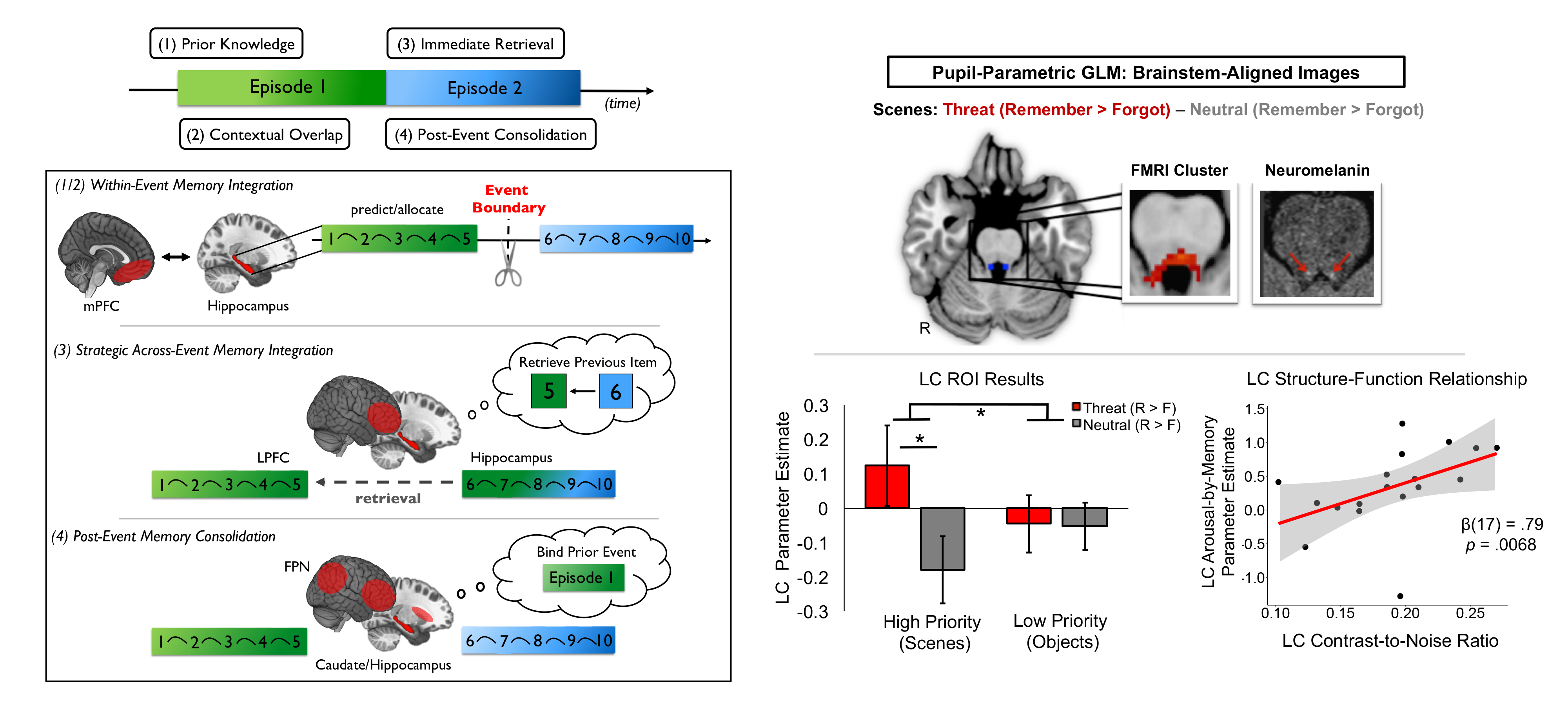
We cannot process and remember everything we encounter. How, then, does the brain prioritize and store important information in memory? What cognitive and neural processes help transform and organize our experiences into memorable events?
The goal of our research is to promote a deeper understanding of how stressful, emotional, or salient circumstances shape the content and structure of memory.
We take a diverse, multimodal approach that includes a combination of neurophysiological (eye-tracking), neuroimaging (fMRI/MRI), and behavioral techniques to study the following topics.
(1) The robust and selective effects of emotional arousal on attention and memory
Memories are not arbitrary records of past events – they are highly selective. Decades of research show that perception and memory are biased towards emotionally arousing experiences, such as a car crash or the birth of a child. However, beyond simply enhancing emotional representations, physiological arousal also exerts a highly selective effect on memory for nearby neutral information. So how do we predict when emotion will enhance or impair attention and memory? Our research shows that physiological arousal (a brain state characterized by intense ‘mental activation’ or the release of stress hormones) enhances the effects of priority in attention and memory, such that processing important information is further enhanced, while processing distracting information is further suppressed. Thus, insofar as attention functions as a spotlight, arousal seems to brighten and focus this spotlight on things that matter, leaving fewer resources to process distracting or irrelevant information. Extending this line of work, we are now investigating: (1) how emotion and motivation influence selectivity in the moment as well as after an event has transpired; (2) how existing memories can affect our ability to learn new information; (3) how arousal adaptively distorts memories to prevent interference; and (4) how unwanted memories can be selectively updated and/or weakened over time.
(2) How emotional states and other contextual factors shape the structure and coherence of memory
Even though our lives unfold continuously, our personal histories don’t strictly mirror this constant stream of information. Instead, our experiences usually become organized into meaningful episodes in memory, much like chapters in a book (e.g., eating lunch at the cafeteria then taking a test in math class). This raises a fundamental yet often unasked question: how does the brain form new episodes in long-term memory? We recently found that a sudden context shift, or ‘event boundary’, elicits a burst in physiological arousal that may help to transform continuous experience into memorable events. Building upon these findings, we are now examining how dynamic fluctuations in different contextual inputs (e.g., our thoughts, emotions, or surroundings) influence neural and memory representations of time and events. Using a variety of techniques, including musical stimuli, continuous behavioral tracking, narratives, and natural language processing tools, we are investigating: (1) how the ebb and flow of emotional states across time shapes the organization of episodic memory; (2) how emotion regulation can be used to re-shape the structure of memory; and (3) how emotion influences the narrative structure and temporal coherence of memory, both in the brain and in clinical populations (e.g., depression, PTSD, and Alzheimer’s disease).
(3) Harnessing forgetting techniques to weaken unwanted memories
The strength and persistence of emotional memories can generally be adaptive: we can draw upon these meaningful experiences to guide how we think, feel, and behave. However, the enduring nature of emotional memories can also become harmful when aversive events spring to mind involuntarily and intrude on future thoughts or behavior. Current treatments for traumatic memories often involve having individuals recall and relive their most negative experiences. Ideally, this process of recollection will allow existing memories to updated, or edited, to reflect the absence of threat. These approaches can be flawed, however, because remembering negative events can also induce distress. While objective physiological and behavioral symptoms are important measures of treatment efficacy, the subjective experience of the patient is a crucial and often overlooked component of mental health treatment. We are interested in studying ways of reactivating and weakening emotional memories indirectly. Identifying such “backdoor” approaches may ultimately provide a safer method of updating memories of trauma and everyday emotional incidents.
(4) The temporally dynamic effects of attentional and arousal states on neural and memory representations
Adaptive behavior relies on our ability to selectively process and catalogue important information in memory. What neural processes support this ability to retain experiences that matter (e.g., something threatening or rewarding)? How do these mechanisms unfold across time? Our research targets the critical role of arousal-related neuromodulators, including norepinephrine and dopamine, in not only signaling the presence of salient stimuli but also storing those representations as durable memories. We also use pupillometry, an indirect biomarker of arousal states, to determine how central arousal systems facilitate mental selectivity, energize adaptive behavior, and prioritize salient memories. In recent fMRI/pupillometry work, we are also examining how the waxing and waning of attentional states across time influence our representations or mental models of the world.
